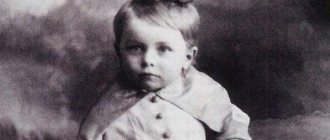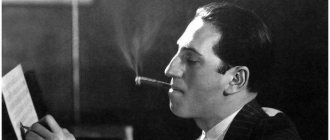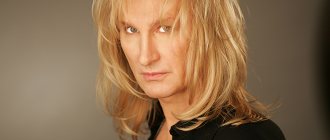WHERE WAS PUSHKIN BORN?
The mother of Alexander Sergeevich Pushkin is Nadezhda Osipovna. Miniature by Xavier de Maistre. 1810
The poet's father is Sergei Lvovich Pushkin. Artist K. K. Gampeln. 1824
A corner of Moscow at the intersection of Malaya Pochtovaya Street and Gospitalny Lane. In 1799 there were wooden houses here. In one of them, in the possession of I.V. Skvortsov, A.S. Pushkin was born. The photo was taken in March 1999.
The poet's sister is Olga Sergeevna. Artist E. A. Plushar. Mid 1830s.
Lev Sergeevich Pushkin, younger brother of Alexander Sergeevich. Artist A. O. Orlovsky. First half of the 1820s.
Alexander Pushkin at the age of eleven.
Coat of arms of the Pushkin family.
Coat of arms of the Hannibal family.
Since the metrical record of the birthplace of A.S. Pushkin became known in 1879 - “in the courtyard of the collegiate registrar Ivan Vasilyevich Skvortsov” - researchers have been trying to determine where Skvortsov’s property was located.
‹
›
Moscow is the birthplace of Alexander Sergeevich Pushkin, this is a textbook statement. However, it was not always like this. At the beginning of the 19th century, in a textbook on modern Russian literature, N. I. Grech wrote that Pushkin was born in St. Petersburg. The author knew the young poet, followed his work, the magazine “Son of the Fatherland” repeatedly published Pushkin’s poems, and during his southern exile, Pushkin corresponded with Grech. Grech's textbook was published at the beginning of 1821, when Pushkin was in Bessarabia, and in October 1822, in a letter to his brother Lev, Alexander Sergeevich asked to send Grech's book. The book has been preserved in the Pushkin library.
For the first time, Moscow as the birthplace of Pushkin was mentioned in the additional volume of the second edition of the “Dictionary of Memorable People” by D. N. Bantysh-Kamensky. The article that appeared in the Dictionary in 1847 was written from the words of the poet’s father, Sergei Lvovich Pushkin.
It was specifically about the Moscow house - the birthplace of Pushkin - that his cousin Alexander Yuryevich Pushkin first mentioned: “In 1798, Sergei Lvovich retired, moved with his family to Moscow and rented the house of the Shcherbatov princesses, near the German settlement, where in 1799 - in the year their son Alexander was born (this place was accompanied by M.P. Pogodin, the publisher and editor of Moskvityanin, with the following note: “Finally we will recognize the house where our unforgettable poet was born!” - Author’s note); our regiment was already on the march at that time, where I received a letter from my sister about the birth of Alexander Sergeevich...” This was the first indication of the birthplace of A.S. Pushkin in Moscow. Indeed, in the German settlement itself there was a house that belonged to the Shcherbatovs: this house was recorded in the confessional register of the Church of the Epiphany, in Elokhov, as belonging to Prince Alexander Alexandrovich and his sisters, princesses Natalya and Varvara Shcherbatov; their wooden house stood on Aptekarsky Lane, not far from Nemetskaya Street - it has not survived, the modern plot number is 15.
Another opinion about the place of birth in Moscow of A. S. Pushkin was expressed in 1853 in an article by P. I. Bartenev, a young and unknown researcher at that time, and later a venerable historian, publisher of documents on Russian history and editor of the magazine “Russian” archive". He wrote that “in 1826 and 27, living on Sobachya Square and often driving along Molchanovka, he [A. S. Pushkin] himself told his friends more than once that he was born on this street, in the parish of St. Nicholas on Chicken Legs, but he could not indicate the house.”
And indeed, in December 1826 - May 1827, Pushkin lived with his friend S. A. Sobolevsky in a small house on the corner of Sobachaya Square and the beginning of Borisoglebsky Lane, from which Bolshaya Molchanovka was literally a few tens of meters. It is quite possible to assume that the “friend” who conveyed the poet’s words to Bartenev was Sobolevsky himself: it is known that Bartenev met with him at the beginning of his Pushkin research and received a lot of information about the poet.
It would seem that the issue has already been resolved if Pushkin himself pointed to the place in Moscow where he was born. But, as we know, the documents found later contradict the words Pushkin said to his “friends” and conveyed to us by Bartenev. After the discovery of the documentary certificate of the birth of A.S. Pushkin, the version about Molchanovka ceased to appear on the pages of works devoted to the biography of the poet. But recently they returned to it again.
It is legitimate to ask how plausible are the memories of Pushkin himself: how could Pushkin know that he was born on Molchanovka? It is natural to assume that his parents told him about this. But I undertake to assert that they hardly remembered where exactly their children were born. After all, during their life in Moscow, that is, from 1798 to 1812, the Pushkins moved 12 times, and it happened that in one year they changed three (!) apartments. How could Sergei Lvovich remember which child was born where - they had six children during this time - and even more so, he, of course, did not deliberately remember where exactly one of them, Alexander, was born.
But there is a convincing explanation for the fact that Pushkin himself claimed that he was born on Molchanovka. The house on Bolshaya Molchanovka was the Moscow house of the young Pushkin, which he remembered more than any others in Moscow, where he lived with his parents. After all, it was in the house on Molchanovka that he, no longer a child, said goodbye to his childhood, to his family, to Moscow, and it was from here that he left for St. Petersburg to enter the Lyceum. Sad events took place in this house, one must think that left a memory of themselves: his first nanny died here, his brother and sister died. It is not surprising that of all the many houses of his childhood in Moscow, he remembered precisely the small house near Molchanovka near the Church of St. Nicholas the Wonderworker on Chicken Legs, which Sergei Lvovich rented in 1810-1811.
For the first time, the metric record of the birth of A. S. Pushkin was published in 1856 in a work on the history of the Tsarskoye Selo Lyceum, but then no attention was paid to it, and, surprisingly, this publication did not interest the first biographer of the poet P. V. Annenkov. Only in 1879, shortly before the opening of the monument to A.S. Pushkin in Moscow, when in the magazine “Russian Antiquity” signed by K.P.P. A biography of A. S. Pushkin appeared, which opened with the publication of the metrical record of the Epiphany Church of Yelokhov, and public attention was attracted to it: “In the courtyard of the college registrar Ivan Vasilyev Skvartsov, a son, Alexander, was born to the resident of the Evo Moeor, Sergius Lvovich Pushkin, baptized on June 8th, successor Count Artemy Ivanovich Vorontsov godfather, mother of the said Pushkin, widow Olga Vasilievna Pushkina.” At the same time, a memorial plaque was unveiled at house No. 57 on Nemetskaya, today’s Baumanskaya Street. However, this place was determined incorrectly in the pre-anniversary rush; already in Soviet times it was revised, and in 1927 the memorial plaque was moved to house number 42 on the same street (later it was placed on the school building nearby).
And finally, in 1980, the author of this article found documents indicating that Ivan Vasilyevich Skvortsov, mentioned in the metric, in May 1799 owned a yard (that is, a plot) on the corner of Malaya Pochtovaya Street and Hospital Lane (No. 4/ 1-3), and, therefore, A.S. Pushkin was born there.
On a plot with a total area of 1035 sq. fathoms (4695 sq. m.) there were two wooden one-story houses: one on the corner with Malaya Pochtovaya Street, with an area of 63 sq. m. fathoms (287 sq. m.), and another along Gospitalny Lane - 60 sq. m. fathoms (272 sq. m), as well as three more small buildings - these were probably just huts for courtyard servants. Two large residential buildings were separated by a 264 square meter garden. fathoms, or 1198 square meters. m. At the rear border of the property there were four wooden outbuildings - stables, barns, sheds, etc.
The same arrangement of the main buildings is depicted on the plan of the German Settlement of the late 18th century.
The memories of contemporaries have been preserved that the Pushkins lived here. Thus, the writer and memoirist M. N. Makarov writes: “Near the Yauza bridge itself, that is, without crossing it to the Golovinsky Palace, almost on the Yauza itself, in some half-brick and half-wooden house lived Sergius Lvovich Pushkin, the father of our famous poet, and all the guests who were then at Count Buturlin’s Saturdays also visited Pushkin. The Buturlin house and the Pushkin house had some kind of ancient connection, wall to wall, a short acquaintance; This was also supplemented by a real close acquaintance of the Pushkins’ apartment with the house of Count Buturlin.” The memoirist, writing down his memories in 1843, attributed these events to 1810 - early 1812, but he himself admitted that he never had a memory for the dates: “... I really, really like to keep myself busy with chronicles and chronicles; but the years, just like the months and numbers, never last me”; he admitted that “... about the above-mentioned years I cannot say anything with numerical certainty.” Another contemporary, Elizaveta Petrovna Yankova, whose grandson wrote down and published her memoirs, said that “... the Pushkins lived somewhere beyond Razgulyai, near the Yelokhov Bridge, they rented a spacious and roomy house there - I can’t say whose exactly it was, but I think that the Buturlins. I went there with my older girls for dance lessons...” She also attributed these events in her life to 1809 or 1810, recalling them almost forty years later, but now we know for sure that this happened much earlier.
Lyceum years
At the age of 12, Pushkin leaves for the Tsarskoye Selo Lyceum with joyful feelings of deliverance from parental tyranny. Here the boy’s first social relationships with peers, warm friendships and first loves will be formed. And here, where Pushkin was born as a poet, the perfection of his youth will overtake him, accompanied by the stormy activity of vulgar and pornographic poetry, dictated by the specifics of this wonderful age. Biographers prefer to mention this aspect of Pushkin’s work in passing.
Numerous epigrams and poems, often riddled with phrases that are incorrect for quotation and outright obscenities, contrast with the first romantically sublime lines that appeared parallel to them.
The last years of the lyceum, marked by the highest degree of freedom that allowed movement outside the educational institution, Alexander Sergeevich Pushkin spends in the company of the hussars settled throughout Tsarskoye Selo. This society gives preference to the poet over the boring poetry evenings where other lyceum students spend their time. Sexual maturation, which has reached perfection, has revealed the remarkable erotic temperament inherited from exotic African ancestors, which recently drove Alexander to a frenzy, finally finds its realization. Here the first sensual contacts take place with representatives of the ancient profession, who also adored the company of the hussars.
Creation
All of Pushkin’s work is divided into two parts, just like he himself. The first is sublime and pompous, glorifying him throughout the world as a great master of words. The second, according to critics, often hidden from readers, is not aesthetically valuable. We are talking about pornographic poetry and vulgar epigrams. To understand what Alexander Sergeevich Pushkin is, one cannot exclude them from attention, since knowing half of Pushkin’s work means trying to understand half a poet, half a man.
In general terms, Pushkin can be characterized not by the likeness of Lensky, not by Onegin, but by the duel between them. An eternal duel, where the cynic Onegin always wins over the amorous idealist Lensky. A mortal fight where Pushkin was born again and again...
Character
Explosive and changeable, in one minute able to replace ringing laughter with deep thoughts - Alexander Sergeevich Pushkin seemed to have several personalities within himself at the same time. The versatility of his emotions had no place in one chest: first one, then the other, taking over his thoughts, quickly replaced each other. Some friends noticed in him a certain infusion of the devil himself: more often than not, cheerful and witty, he could suddenly explode with anger over any little thing, which resulted in frequent duels, appointed by himself.
He was not afraid of death. During duels, while waiting for his opponent’s shot, Pushkin smiled cynically, writing another epigram, hummed something indifferently, or even, as during the Bessarabian exile, ate cherries.
He had a sarcastic and cynical mind, at the same time childishly playful and cheerful. And again, these two characteristics were replaced by rancor and vindictiveness. Pushkin’s character was too multifaceted to be summarized in a few lines.
However, this frantic play of contradictions gave rise to his comprehensive inspiration, causing suffering to the poet himself, and this turned into creative potential.











